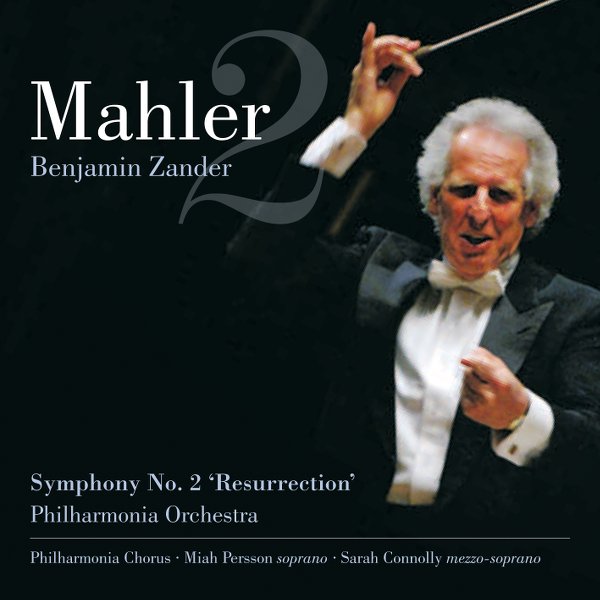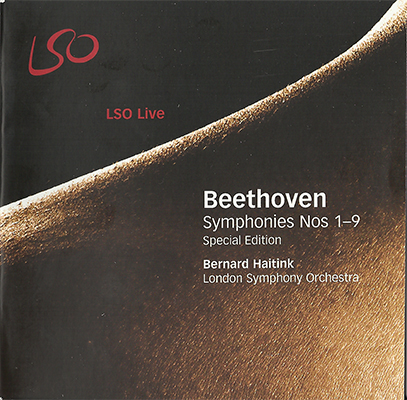
Mahler: Symphony no 2 “Resurrection” – Persson, Connolly, Zander (2013)
FLAC (tracks) 24 bit/192 kHz | 2 CDs | Digital Booklet | 3.73 GB
Genre: Classical | Official Digital Download – Source: Linn Records
Benjamin Zander and Linn launch their new partnership with Mahler’s hugely popular ‘Resurrection’ Symphony; exceptionally challenging and thrillingly powerful it is the perfect showcase for Zander’s distinctive balance of insightful musicianship and emotional intensity. A GRAMMY-nominated conductor, Zander has established an impressive reputation as arguably the most devoted Mahlerian of today, having previously released seven of the nine symphonies to critical acclaim.
Together with the Philharmonia Orchestra Zander’s recordings of Mahler symphonies have inspired critics worldwide to use superlatives such as ‘revelatory’, ‘exhilarating’, ‘illuminating’ and ‘remarkable’.
An infectiously enthusiastic communicator, Benjamin Zander has also recorded a detailed and highly informative discussion to accompany the recording (available to download for free).
The featured soloists are Sarah Connolly, one of the foremost British mezzo sopranos who has impressed at La Scala and Glyndebourne, and Swedish soprano Miah Persson, who is in great demand with the major opera houses including Royal Opera House Covent Garden, Metropolitan Opera New York.
Further commendations for his Mahler Symphonies include: nominated for a GRAMMY Award in the category of Best Orchestral Performance (Ninth Symphony), named a ‘Top 10 Recording of 2001’ by the New York Times and The Sunday Times (Fourth and Fifth Symphonies respectively), named a ‘Recording of the Year’ by Boston Globe, The Sunday Times, and Fanfare Magazine (Sixth Symphony).
Benjamin Zander is the conductor of The Boston Philharmonic Orchestra and a guest conductor around the world.
With London’s famed Philharmonia Orchestra, he is recording the complete cycle of Mahler symphonies, recordings which have been received with extraordinary critical acclaim and several awards.
Composer: Gustav Mahler
Performer: Sarah Connolly, Miah Persson
Conductor: Benjamin Zander
Orchestra/Ensemble: Philharmonia Orchestra
Reviews:
Most of us are old enough to remember when a new recording, or a performance, of the “Resurrection” was rare enough to be an event. Nowadays, it happens so often we run the risk of becoming jaded, perhaps even by the music itself. Fortunately, this new recording, while not groundbreaking, in any sense of the word, reaffirms both this Symphony’s transformative power and Benjamin Zander’s excellence as a Mahlerian.
Zander, it will be recalled, recorded a chunk of Mahler’s symphonies for Telarc before that label itself went through its own transformation several years ago. The fear was that Zander’s cycle would be stopped short, but here it is picking up where it left off, and rumor has it that the Seventh and Eighth symphonies also will be recorded and released by Linn Records in due course.
The conductor’s profile as a Mahler conductor has not changed in the interim. He remains a highly conscientious, objective interpreter who resists the temptation to juice up the music. The days of Leonard Bernstein (for example), who worked hard to “sell” these symphonies to a larger audience, are behind us. Mahler has taken his deserved place in musical history and requires no one’s defense and no one’s special pleading. Zander’s recordings remind me of Rafael Kubelík’s in their lack of exaggeration. A ff is not interpreted as an invitation to play fff , and a pp is not interpreted as an excuse to play ppp.
The first movement, which sensibly has the first SACD to itself (sensibly, because Mahler asked for a long pause between the first and second movements) lasts 22:02, and the tempos throughout are nicely judged. One risk with music this demonstrative is that listeners will get tired out by a succession of purple passages and one climax after another, but Zander has an excellent sense of the movement’s architecture and pacing. In the second movement (10:01), the opening theme is given character by little hesitations or falterings in its forward progress. This easily could have been overdone, but Zander resists the temptation. In fact, this entire movement has a nicely restrained feeling, which makes the sudden climaxes and interruptions even more effective. I love the slightly gauche way in which the orchestra plays the “St. Antonius” theme in third movement (12:44); it’s done like a peasant dance, but again, what other conductors might have underlined, Zander quietly suggests. In both of these movements, Zander is subtle enough to leave you wondering whether or not Mahler intended an element of parody at all.
Sarah Connolly is gorgeously human and comforting in the “Urlicht” movement, and Zander’s tempo (5:47 is the movement’s timing) allows the music to breathe deeply without losing its forward motion. The first time I heard this, the sun came out from behind the clouds just as Connolly was singing “Da kam ein Engelein” (Then came a little angel). While I can’t attribute that effect to Connolly or to Zander, I took it as a sign of good karma related to this new recording!
The lengthy final movement (38:57) goes very well, and if Zander doesn’t always exploit atmosphere (for example, in the section corresponding to what Mahler described as the song of a nightingale), drama unfolds as the music takes its course, and by the time the chorus first enters, we feel that we have been taken on a great journey and that it is nearing its end. The only miscalculation is that, when they first enter, Persson and Connolly are too close to the listener to be realistic; it’s as if both of them are singing over the listener’s shoulder. The choir sings and is recorded with great presence, and the passage leading up to and including “Bereite dich” is exceptionally moving. The orchestral postlude does not come as an anticlimax, and by the time the Symphony comes to a close, one feels, if not resurrected, then at least renewed.
I played this recording three times in succession in one afternoon. I was not exhausted by it; in fact, I couldn’t wait to put the first disc back in the player and start all over again. Perhaps some will want a “Resurrection” that temporarily obliterates everything else, but I found Zander’s sane, organized, and humane reading very effective, and I think it will have a long shelf life. With Linn’s exciting, clear engineering, as an added attraction, this new “Resurrection” certainly belongs among the work’s top 10 recordings.
By the way, apparently there is a three-disc version of this set in which Zander, as with the Telarc releases, discusses the Symphony on the third disc. My review copy had two discs and did not seem to be missing a third, but a note on the back cover invited the reader to download Zander’s discussion from Linn’s website.
Tracklist:
1. Symphony no 2 in C minor “Resurrection” by Gustav Mahler
Performer: Sarah Connolly (Mezzo Soprano), Miah Persson (Soprano)
Conductor: Benjamin Zander
Orchestra/Ensemble: Philharmonia Orchestra
Period: Romantic
Written: 1888/1896; Germany
Venue: Watford Colosseum, London, England
Length: 89 Minutes 40 Secs.
Download:
mqs.link_MahlerSymphnyn2ResurrectinPerssnCnnllyZander2013LINN24192.part1.rar
mqs.link_MahlerSymphnyn2ResurrectinPerssnCnnllyZander2013LINN24192.part2.rar
mqs.link_MahlerSymphnyn2ResurrectinPerssnCnnllyZander2013LINN24192.part3.rar
mqs.link_MahlerSymphnyn2ResurrectinPerssnCnnllyZander2013LINN24192.part4.rar




















![Otto Klemperer - Mozart: Die Zauberflote (The Magic Flute) (1964/2017) [Qobuz FLAC 24bit/96kHz] Otto Klemperer - Mozart: Die Zauberflote (The Magic Flute) (1964/2017) [Qobuz FLAC 24bit/96kHz]](https://getimg.link/images/imgimgimg/uploads/2017/11/gM42CdU.jpg)
![Michael Tilson Thomas, The San Francisco Symphony - The Mahler Project (2010) [FLAC 24bit/96kHz] Michael Tilson Thomas, The San Francisco Symphony - The Mahler Project (2010) [FLAC 24bit/96kHz]](https://getimg.link/images/imgimgimg/uploads/2017/01/HHDTsz0.jpg)
![Sir Simon Rattle, Berliner Philharmoniker - Jean Sibelius - Symphonies Nos. 1-7 (2015) [Blu-ray Disc + Pure Audio Blu-ray Disc + FLAC 5.1 24bit/192kHz] Sir Simon Rattle, Berliner Philharmoniker - Jean Sibelius - Symphonies Nos. 1-7 (2015) [Blu-ray Disc + Pure Audio Blu-ray Disc + FLAC 5.1 24bit/192kHz]](https://getimg.link/images/imgimgimg/uploads/2016/02/htbd2jO.jpg)

![Carl Nielsen - Symphonies Nos. 1-6 - London Symphony Orchestra, Sir Colin Davis (2015) [Blu-Ray Pure Audio Disc + DSF Stereo DSD64/2.82MHz] Carl Nielsen - Symphonies Nos. 1-6 - London Symphony Orchestra, Sir Colin Davis (2015) [Blu-Ray Pure Audio Disc + DSF Stereo DSD64/2.82MHz]](https://getimg.link/images/imgimgimg/uploads/2015/09/Wnf48VE.jpg)
![Pacifica Quartet - Dmitri Shostakovich and his Contemporaries: The Soviet Experience Vol. 1-4 (2011-2013) [24bit FLAC] Pacifica Quartet - Dmitri Shostakovich and his Contemporaries: The Soviet Experience Vol. 1-4 (2011-2013) [24bit FLAC]](https://getimg.link/images/imgimgimg/uploads/2017/07/ntIbtOp.jpg)
![Mariss Jansons - Mahler: Symphony No. 2 in C Minor "Resurrection" (2018) [FLAC 24bit/48kHz] Mariss Jansons - Mahler: Symphony No. 2 in C Minor "Resurrection" (2018) [FLAC 24bit/48kHz]](https://getimg.link/images/imgimgimg/uploads/2019/05/KaVkfWL.jpg)
![Piers Lane, Howard Shelley - Williamson: Complete Piano Concertos (2014) [FLAC 24bit/96kHz] Piers Lane, Howard Shelley - Williamson: Complete Piano Concertos (2014) [FLAC 24bit/96kHz]](https://getimg.link/images/imgimgimg/uploads/2017/01/PsKdW8Y.jpg)
![Itzhak Perlman - The Complete Warner Recordings 1972-1980 (2015) [FLAC 24bit/96kHz] Itzhak Perlman - The Complete Warner Recordings 1972-1980 (2015) [FLAC 24bit/96kHz]](https://getimg.link/images/imgimgimg/uploads/2019/12/IpmBmeR.jpg)
![Benjamin Schmid, Oulu Symphony, Johannes Gustavsson - Klami & Englund: Violin Concertos (2016) [ProStudioMasters FLAC 24bit/96kHz] Benjamin Schmid, Oulu Symphony, Johannes Gustavsson - Klami & Englund: Violin Concertos (2016) [ProStudioMasters FLAC 24bit/96kHz]](https://getimg.link/images/imgimgimg/uploads/2018/11/BvIZUg0.jpg)
![Miah Persson, Budapest Festival Orchestra, Ivan Fischer - Mahler: Symphony No. 4 (2009) [nativeDSDmusic DSF DSD64/2.82MHz] Miah Persson, Budapest Festival Orchestra, Ivan Fischer - Mahler: Symphony No. 4 (2009) [nativeDSDmusic DSF DSD64/2.82MHz]](https://getimg.link/images/imgimgimg/uploads/2018/11/DRd52Ah.jpg)
![Gustav Mahler - 10 Symphonien - Symphonieorchester des Bayerischen Rundfunks, Rafael Kubelik (2015) [AcousticSounds FLAC 24bit/96kHz] Gustav Mahler - 10 Symphonien - Symphonieorchester des Bayerischen Rundfunks, Rafael Kubelik (2015) [AcousticSounds FLAC 24bit/96kHz]](https://getimg.link/images/imgimgimg/uploads/2017/07/yx49aDw.jpg)
![Miah Persson, Budapest Festival Orchestra, Ivan Fischer - Mahler: Symphony No. 5 (2013) [nativeDSDmusic DSF DSD64/2.82MHz] Miah Persson, Budapest Festival Orchestra, Ivan Fischer - Mahler: Symphony No. 5 (2013) [nativeDSDmusic DSF DSD64/2.82MHz]](https://getimg.link/images/imgimgimg/uploads/2018/11/SPEpHT6.jpg)
![Antonio Pappano - Bernstein: Symphonies Nos 1-3 - Prelude, Fugue & Riffs (2018) [FLAC 24bit/96kHz] Antonio Pappano - Bernstein: Symphonies Nos 1-3 - Prelude, Fugue & Riffs (2018) [FLAC 24bit/96kHz]](https://getimg.link/images/imgimgimg/uploads/2019/06/OdR4Cm6.jpg)
![Otto Klemperer - Mozart: The Last 6 Symphonies (2012) [3x SACD] {SACD ISO + FLAC 24bit/88,2kHz} Otto Klemperer - Mozart: The Last 6 Symphonies (2012) [3x SACD] {SACD ISO + FLAC 24bit/88,2kHz}](https://getimg.link/images/imgimgimg/uploads/2017/11/wOEFEh8.jpg)